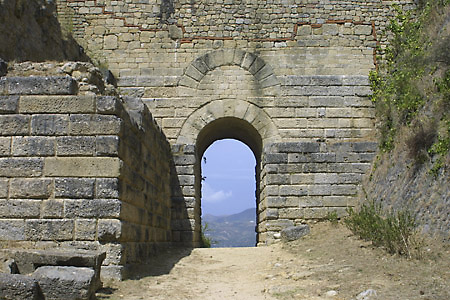
Zeno of Elea—the philosopher of footraces that never end and arrows that never reach their target—seems a figure so lost in abstractions and infinities that it’s hard to imagine him living in some particular place and time. But Elea was a real town, a sixth-century B.C.E. Greek settlement on the Tyrrhenian coast of Italy. The site is now the Italian village of Velia, about 100 kilometers south of Naples.
The massive stonework wall and gate shown above, known as the Porta Rosa, lies atop a ridge separating two neighborhoods of ancient Elea. I visited several years ago, and ever since then I’ve been perplexed by that gate. I’m now going to be writing about Zeno’s hometown for an upcoming American Scientist column, and so I thought I would ask the world for help in resolving the mystery of Veliagate.
What puzzles me, of course, is the eyebrow above the arch. It looks as if the gate was originally built a meter higher, and then lowered. Why would anyone do that? I can imagine how erosion of the ridge and the roadway might have made the opening taller than it was at the outset—but what’s the harm of that? And if the city engineers did want to maintain the original headroom, wouldn’t it be much easier to build up the roadway than to lower the arch?
Or am I wrong that the two arches represent two stages in the history of the gate? Maybe the “eyebrow” is really some sort of reinforcement?
I should mention that the Porta Rosa also has a bit of topological interest. It is built at a saddle point in the ridge. The lower passage (seen in the photograph) connects two valleys, while the roadway crossing above the arch links two hilltops.
Finally, I have another question about Greek mathematics. The big literary figures of ancient Greece were mostly Athenians, and so were the historians and political writers and the major philosophers. But when it comes to the nerdy Greeks, they seem to have been scattered all over the Mediterranean world. Euclid, Diophantus and Hypatia were Alexandrians; Pythagoras came from the island of Samos; Archimedes lived in Syracuse, on Sicily; and Zeno, as already noted, was Italian. Coincidence, or shall we speculate about the different intellectual environments of the center and the periphery?